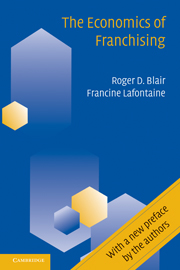Book contents
- Frontmatter
- Contents
- Preface
- 1 Introduction
- 2 Four Popular Misconceptions about Franchising
- 3 Franchise Contracts
- 4 Franchising, Vertical Integration, and Vertical Restraints
- 5 Quality Control
- 6 Franchise Tying Contracts
- 7 Vertical Price Controls in Franchising
- 8 Encroachment
- 9 Advertising and Promotion
- 10 Termination and Non-Renewal
- 11 Concluding Remarks
- Articles, Books, and Other Publications
- Cases, Codes, and Statutes
- Index
7 - Vertical Price Controls in Franchising
Published online by Cambridge University Press: 24 May 2010
- Frontmatter
- Contents
- Preface
- 1 Introduction
- 2 Four Popular Misconceptions about Franchising
- 3 Franchise Contracts
- 4 Franchising, Vertical Integration, and Vertical Restraints
- 5 Quality Control
- 6 Franchise Tying Contracts
- 7 Vertical Price Controls in Franchising
- 8 Encroachment
- 9 Advertising and Promotion
- 10 Termination and Non-Renewal
- 11 Concluding Remarks
- Articles, Books, and Other Publications
- Cases, Codes, and Statutes
- Index
Summary
“Why do your prices vary from one restaurant to another and why do some restaurants charge for extra condiments?[”]
Approximately 85 percent of McDonald's restaurants are locally owned and operated. As independent businesspeople, each individual determines his or her own prices taking their operating costs and the company's recommendations into consideration. Therefore, prices do vary from one McDonald's restaurant to another. Also, for this same reason, charges for condiments may vary from one McDonald's restaurant to another.
(McDonald's Corporation Web site, June 2003)Introduction
Prices vary somewhat from outlet to outlet in most franchised chains. This has been confirmed in several empirical studies, including Lafontaine (1995b), Graddy (1997), Thomadsen (2002), and Kalnins (2003), all of which examined price data they had gathered from the individual outlets of large fast-food chains within relatively small geographical markets. Moreover, Lafontaine (1999) has examined the relationship between the extent of franchising and the degree of price dispersion in local markets, namely the Pittsburgh and the Detroit metropolitan areas. She finds that several fast-food chains allow some price dispersion even within their set of corporate stores. The amount of price dispersion, however, is larger for fully franchised than for fully corporate chains. She finds the greatest total amount of price dispersion among those chains with a mix of corporate and franchised stores.
Although the quote above from the McDonald's Web site suggests that price differences across outlets are a normal and accepted part of franchising, it is not uncommon for franchisors and franchisees to disagree about the prices that the franchisees charge their customers.
- Type
- Chapter
- Information
- The Economics of Franchising , pp. 174 - 201Publisher: Cambridge University PressPrint publication year: 2005



